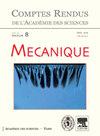Hydrodynamic quantum field theory: the free particle
IF 1
4区 工程技术
Q4 MECHANICS
引用次数: 15
Abstract
We revisit de Broglie’s double-solution pilot-wave theory in light of insights gained from the hydrodynamic pilot-wave system discovered by Couder and Fort [1]. de Broglie proposed that quantum particles are characterized by an internal oscillation at the Compton frequency, at which rest mass energy is exchanged with field energy. He further proposed that the resulting pilot-wave field satisfies the Klein–Gordon equation. While he developed a guidance equation for the particle, he did not specify how the particle generates the wave. Informed by the hydrodynamic pilot-wave system, we explore a variant of de Broglie’s mechanics in which the form of the Compton-scale dynamic interaction between particle and pilot wave is specified. The particle is modeled as a localized periodic disturbance of the Klein–Gordon field at twice the Compton frequency. We simulate the evolution of the particle position by assuming that the particle is propelled by the local gradient of its pilot wave field. Resonance is achieved between the particle and its pilot wave, leading to self-excited motion of the particle. The particle locks into quasi-steady motion characterized by a mean momentum p̄ =ħk, where k is the wavenumber of the surrounding matter waves. Speed modulations along the particle path arise with the de Broglie wavelength and frequency ck. The emergent dynamics is strongly reminiscent of that arising in the hydrodynamic pilot-wave system, on the basis of which we anticipate the emergence of quantum statistics in various settings. Our results suggest the potential value of a new hydrodynamically-inspired pilot-wave theory for the motion of quantum particles.流体力学量子场论:自由粒子
根据Couder和Fort[1]发现的流体动力导波系统的见解,我们重新审视了德布罗意的双解导波理论。德布罗意提出,量子粒子的特征是在康普顿频率下的内部振荡,在这个频率下,静止质能与场能交换。他进一步提出,由此得到的导波场满足Klein-Gordon方程。虽然他为粒子建立了一个引导方程,但他没有具体说明粒子是如何产生波的。根据流体动力导波系统,我们探索了德布罗意力学的一种变体,其中粒子和导波之间的康普顿尺度动态相互作用的形式被指定。该粒子被建模为克莱因-戈登场在两倍康普顿频率下的局部周期性扰动。我们通过假设粒子由其导波场的局部梯度推动来模拟粒子位置的演变。粒子与其导波之间产生共振,导致粒子的自激运动。粒子锁定为准稳定运动,其特征是平均动量p ā =ħk,其中k是周围物质波的波数。沿粒子路径的速度调制随德布罗意波长和频率ck而出现。涌现动力学强烈地让人想起了在流体动力导波系统中出现的动力学,在此基础上,我们预测了量子统计在各种情况下的出现。我们的结果表明,一种新的流体动力学启发的导波理论对量子粒子的运动具有潜在的价值。
本文章由计算机程序翻译,如有差异,请以英文原文为准。
求助全文
约1分钟内获得全文
求助全文
来源期刊

Comptes Rendus Mecanique
物理-力学
CiteScore
1.40
自引率
0.00%
发文量
0
审稿时长
12 months
期刊介绍:
The Comptes rendus - Mécanique cover all fields of the discipline: Logic, Combinatorics, Number Theory, Group Theory, Mathematical Analysis, (Partial) Differential Equations, Geometry, Topology, Dynamical systems, Mathematical Physics, Mathematical Problems in Mechanics, Signal Theory, Mathematical Economics, …
The journal publishes original and high-quality research articles. These can be in either in English or in French, with an abstract in both languages. An abridged version of the main text in the second language may also be included.
 求助内容:
求助内容: 应助结果提醒方式:
应助结果提醒方式:


